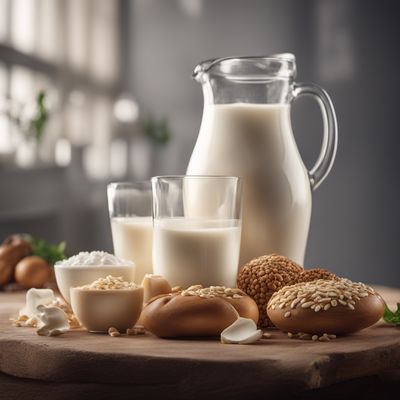
Ingredient
Other milks
Exploring the World of Alternative Dairy-Free Milks
Other milks are non-dairy beverages made from a variety of plant sources such as nuts, seeds, grains, and legumes. They come in a wide range of flavors, textures, and consistencies. Almond milk, soy milk, oat milk, coconut milk, and rice milk are some of the most popular options. These milks are typically produced by blending or soaking the chosen ingredient with water, then straining the mixture to remove any solids. The resulting liquid is creamy, smooth, and can be enjoyed on its own, in coffee, tea, smoothies, or used in cooking and baking. Each type of milk has its own unique taste and texture, ranging from nutty and creamy (almond milk) to rich and velvety (coconut milk). They also vary in thickness, with some being thinner like rice milk and others being thicker like oat milk. Other milks are often fortified with vitamins and minerals to provide a similar nutritional profile to cow's milk.
Origins and history
The use of alternative milks dates back centuries, with soy milk being one of the earliest known examples, originating in China around 2000 BCE. Almond milk has been consumed in the Middle East since ancient times, while rice milk has been a staple in Asian cuisines for centuries. Coconut milk has a long history in tropical regions, particularly in Southeast Asia. Oat milk gained popularity in the 1990s as a dairy-free option in Sweden and has since spread worldwide. The rise of alternative milks can be attributed to the increasing demand for plant-based and vegan products, as well as the growing awareness of lactose intolerance and dairy allergies.
Nutritional information
Other milks are generally lower in calories and fat compared to cow's milk. They are often fortified with calcium, vitamin D, and other nutrients to match the nutritional content of dairy milk. These milks can be a good source of vitamins, minerals, and antioxidants, depending on the specific type. They are typically lower in protein than cow's milk, with almond milk containing around 1 gram of protein per serving, soy milk containing around 7 grams, and oat milk containing around 3 grams.
Allergens
Other milks can be allergenic for individuals with nut or soy allergies. Almond milk and other nut-based milks should be avoided by those with nut allergies. Soy milk is not suitable for individuals with soy allergies. It is important to read labels carefully and choose alternative milks that are free from allergens if necessary.
How to select
When selecting other milks, it is important to check the ingredient list for any additives or sweeteners that may be undesirable. Look for options that are made with minimal ingredients and avoid those with added sugars or artificial flavors. Opt for unsweetened varieties if you prefer a more neutral taste. Additionally, choose milks that are fortified with calcium and vitamin D to ensure you are getting similar nutritional benefits to cow's milk.
Storage recommendations
Other milks should be stored in the refrigerator to maintain their freshness and quality. Once opened, they should be consumed within a week. It is important to check the expiration date on the packaging and follow the manufacturer's recommendations for storage.
How to produce
While it is possible to produce other milks at home, it requires soaking, blending, and straining the chosen ingredient. The process can be time-consuming and may require specialized equipment such as a high-powered blender or nut milk bag. However, for those interested in making their own alternative milks, there are numerous recipes and tutorials available online that provide step-by-step instructions.
Preparation tips
Other milks can be used as a dairy-free substitute in various recipes, including smoothies, baked goods, sauces, and soups. They can also be enjoyed on their own or added to coffee and tea. When using other milks in cooking or baking, it is important to consider their different consistencies and flavors. For example, almond milk works well in desserts, while soy milk is a great option for savory dishes. Oat milk adds creaminess to sauces and soups, and coconut milk lends a tropical touch to curries and desserts. Experiment with different types of other milks to find the best fit for your culinary creations.
Substitutions
N/A (There are no suitable substitutions for other milks as they are unique in their plant-based composition and flavor profiles.)
Culinary uses
Other milks are widely used in vegan and dairy-free cooking and baking. They can be used as a substitute for cow's milk in recipes such as smoothies, pancakes, muffins, and creamy sauces. Almond milk is often used in desserts like puddings and ice creams, while soy milk is commonly used in Asian cuisines and for making tofu. Oat milk is a popular choice for lattes and coffee drinks, while coconut milk is a staple in curries, soups, and tropical desserts. Rice milk is versatile and can be used in both sweet and savory dishes.
Availability
Other milks are commonly available in grocery stores, supermarkets, and health food stores worldwide. They can also be found in online retailers and specialty stores catering to dietary restrictions and vegan lifestyles.
More ingredients from this category

Human milk
Nature's Nourishment

Elk milk
The Nutritional Elixir: Unveiling the Wonders of Elk Milk

Milk from other milk producer animals
The Versatile Dairy Elixir

Reindeer milk
Arctic Elixir: Unveiling the Secrets of Reindeer Milk

Dromedary milk
The Versatile Dromedary Milk

Bactrian camel milk
"The Golden Elixir: Unveiling the Richness of Bactrian Camel Milk"

